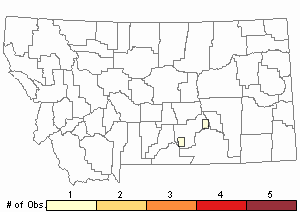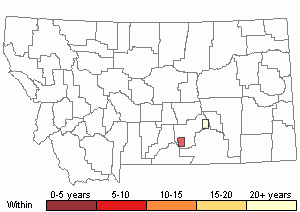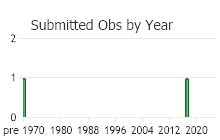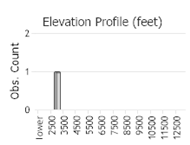View in other NatureServe Network Field Guides
NatureServe
Montana
Utah
Wyoming
Idaho
Wisconsin
British Columbia
South Carolina
Yukon
California
New York
Western Centaury - Centaurium exaltatum
Other Names:
Zeltnera exaltata
State Rank Reason (see State Rank above)
Centaurium exaltatum is known from two locations in south-central Montana. Plants were initially documented in 1890 at an imprecise location by J.W. Blankinship, a notable botanist. Fast-forward 127 years, and a new population was discovered in 2017 at a wetland mitigation site developed by the Montana Department of Transportation. Plants have not been found in subsequent monitoring from 2018 to 2024. It is presumed that populations require periodic soil or hydrological disturbance. Further investigation at the 2017 location is needed to assess disturbance regimes and the possibility for a seed bank. Based on the 2017 observation, the status of Centaurium exaltatum has been upgraded to a Montana Species of Concern with a conservation status rank of S1.
General Description
PLANTS: Small, annual forbs with fibrous roots and a single, but sometimes branched stem, 10 to 60 cm tall. Across its range, the species exhibits great variation in the number of stems, presence or absence of basal leaves at flowering, and in leaf width. Sources: Lesica et al. 2022; Pringle in Flora of North America [FNA] 2023.
LEAVES: Basal and cauline (stem) present and similar, or larger. Basal leaves sometimes whither by flowering. Leaves arranged opposite on stem. Lower (or all) leaf blades oblong-elliptic to lanceolate and upper blades linear, in shape, 1-3 cm long. Sources: Lesica et al. 2022; Pringle in FNA 2023.
INFLORESCENCE: Narrow cyme with two lateral axes, producing few pink to white flowers – salverform in shape. Calyx: 4, linear, 6-11 mm long, and united at base. Corolla: 4, 10-20 mm long. Petal lobes are lanceolate to oblong or narrowly elliptic-obovate, and about half as long as the tube - 2.5-6 mm by 0.8-2.5 mm; tips are truncate to rounded or obtuse. Tube is 6-13 mm long. Stamens: Exserted. Pistil: Single with 1 style and stigma. Sources: Lesica et al. 2022; Pringle in FNA 2023.
TAXONOMY & NOMENCLATURE
The native North American species have been transferred from the genus Centaurium to Zeltnera - in the Flora of North America and Flora of the Pacific Northwest - 2nd Edition. The taxonomic shift is based on molecular phylogenetic studies (Mansion 2004; Mansion and Struwe 2004; Pringle in FNA 2023).
The revised treatments separate Centaurium and Zeltnera on the following morphology:
Centaurium
* Non-native species to North America
* Basal Leaves: rosette usually present during flowering
* Flowers: white to yellowish-pink
* Pistil with 2 stigmas crescent-shaped (elliptic to ovate to orbiculate) – as long as or longer than wide.
* Capsule cylindric
Zeltnera
* Native species to North America
* Basal Leaves: rosette absent by flowering
* Flowers: pink, rose-violet, or white.
* Pistil with 2 stigmas that are crescent to fan-shaped or 1 stigma with 2 fan-shaped lobes – as wide as or wider than long
* Capsule fusiform (ovoid to ellipsoid)
Centaurium comes from the Greek word kentauros meaning "centaur" which alludes to the plant’s supposed medicinal use by Chiron in Greek mythology (Pringle in FNA 2023).
Phenology
Flowering from spring to early fall (range-wide). Montana’s populations were found in late June and late August.
Diagnostic Characteristics
Members of the Gentian Family (Gentianaceae) have opposite leaves, glabrous foliage, and flowers with 4 to 5 tubular petals of equal size. Traditionally, the genus
Centaurium is distinguished from other family members by a salverform flower – where lobes spread at right angles to the tube, a long and narrow corolla tube, and the of lack membranous tissue between the petals.
The
Manual of Montana Vascular Plants (Lesica et al. 2022) retains a traditional taxonomic treatment:
Western Centaury -
Centaurium exaltatum, native, SOC
* Leaves: Basal rosette of basal leaves that wither by flowering time; thus, appearing all cauline
* Inflorescence: Little branched, few flowered
* Seeds: Dark reddish brown to nearly black
Common Centaury -
Centaurium erythraea, non-native
* Leaves: Small rosette of basal leaves present during flowering and anthesis
* Inflorescence: Densely branched, many flowers
* Seeds: Brown
Range Comments
Western Centaury occurs from the eastern Cascade Mountains from British Columbia, Canada to Baja California and east to the northern Great Plains (Giblin et al. [eds.] 2018).
Observations in Montana Natural Heritage Program Database
Number of Observations: 2
(Click on the following maps and charts to see full sized version)
Map Help and Descriptions
Relative Density

Recency



 (Observations spanning multiple months or years are excluded from time charts)
(Observations spanning multiple months or years are excluded from time charts)
Habitat
Across its range, Western Centaury grow in stream banks, marshes, lakeshores, along margins of hot springs and vernal pools to alkaline wetlands surrounded by desert (Pringle in FNA 2023). In Montana, plants are found in moist alkaline soil of shallow wetlands in the plains zone (Lesica et al. 2022).
National Vegetation Classification System Groups Associated with this Species
Wetland and Riparian
Alkaline - Saline Wetlands
Riparian Shrubland
Reproductive Characteristics
Plants reproduce by seed.
FRUITS & GENETICS
The fruit is a capsule. Capsule is cylindric, 7-15 mm long. Seeds are dark reddish brown to nearly black. Seeds are diploid with a chromosome number of 2n = 40 or 74 (Mansion and Zeltner 2004). In general, plants at the southern parts of the range have lower chromosome numbers than those in the northern portions (Mansion and Zeltner 2004).
Management
It is thought that Western Centaury plants require some type of disturbance with soils or hydrology to sustain their populations.
Stewardship Responsibility
Threats or Limiting Factors
An overall State Threat Score of “Very High” is assigned to Western Centaury (see Conservation Status Summary, 2025). A population of flowering and vegetated individuals emerged in 2017 during the construction of a wetland mitigation site. Although unknown but assumed that seeds were present and that disturbance promoted germination. During annual monitoring the population was not observed from 2018 to 2024. It is assumed that the species requires a disturbance regime to persist, such as periodic flooding and drying or soil disturbance to reduce plant competition. More information is needed to validate these assumptions.
References
- Literature Cited AboveLegend:
 View Online Publication
View Online Publication Lesica, P., M.T. Lavin, and P.F. Stickney. 2022. Manual of Montana Vascular Plants, Second Edition. Fort Worth, TX: BRIT Press. viii + 779 p.
Lesica, P., M.T. Lavin, and P.F. Stickney. 2022. Manual of Montana Vascular Plants, Second Edition. Fort Worth, TX: BRIT Press. viii + 779 p. Respec. 2016. Kindsfater Mitigation Site, Yellowstone County, Montana, Montana Department of Transportation Wetland Mitigation Monitoring Report: Year 2016. Helena, MT: Respec. 37 p plus appendices.
Respec. 2016. Kindsfater Mitigation Site, Yellowstone County, Montana, Montana Department of Transportation Wetland Mitigation Monitoring Report: Year 2016. Helena, MT: Respec. 37 p plus appendices. Seibert, Catherine. 2017. Herbarium specimen of Centaurium exaltatum. Montana State University Herbarium, Bozeman, Montana.
Seibert, Catherine. 2017. Herbarium specimen of Centaurium exaltatum. Montana State University Herbarium, Bozeman, Montana.
- Additional ReferencesLegend:
 View Online Publication
View Online Publication
Do you know of a citation we're missing? Lesica, P., M.T. Lavin, and P.F. Stickney. 2012. Manual of Montana Vascular Plants. Fort Worth, TX: BRIT Press. viii + 771 p.
Lesica, P., M.T. Lavin, and P.F. Stickney. 2012. Manual of Montana Vascular Plants. Fort Worth, TX: BRIT Press. viii + 771 p.
- Web Search Engines for Articles on "Western Centaury"





